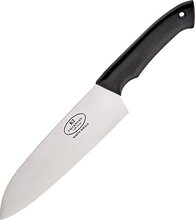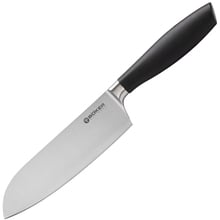Buying knives can be an intimidating experience for many people, especially when considering larger knives or those with which they have no prior experience. It's one thing to purchase a set of steak knives that you've used all your life, and quite another to buy a knife that you've only used once or with which you have no experience. The latter scenario is common when people look for a suitable Santoku knife.
If you're not familiar with the world of Santoku knives, it can be easy to get lost. What type of handle is best? What are those dimples along the blade's edge and what are they for? Why are some knife blades higher than others? How does maintenance look for such a delicate knife to keep it intact? Is it really necessary to buy this knife, or will your collection of other kitchen knives meet your needs?
The word “santoku” literally means “three virtues”. This name was chosen to represent the knife’s three main uses - slicing, dicing, and chopping. Although the use of a Santoku knife is very similar to that of a carving knife, it is immediately noticeable how distinctly these two types of knives differ in design. What you might not know is that they also differ in their usage techniques.
A Santoku knife is more specialized in its use compared to a carving knife. Compared to a chef’s knife, it focuses more on smaller, more precise, and finer tasks, such as making decorative thin slices of vegetables. The technique required to fully utilize a Santoku knife is somewhat more challenging to master than that of a carving knife, but ultimately leads to finer slices and more precise cuts. Importantly, completing a task will take much less time.
These recommendations are designed to help you choose a quality Santoku knife. In creating this guide, we spent hours researching and comparing Santoku knives, verifying which aspects are preferred by top chefs, from the tip of the blade to the handle. To a small extent, we included our own experiences with this type of knife to give you a better idea of what it's like to work with different kinds of Santoku knives.
The Importance of Blade Width and Cutting Angle
If you’ve paid attention to the above text or already know something about Santoku knives, it won’t be surprising that sharp and thin blades are particularly important for Santoku knives. The blade needs to be honed to a very sharp angle to allow it to slice through any fruit or vegetable you put in its path. When working with the knife, finger movement is minimal. Remember that with a Santoku knife, you only slice in an up-and-down motion. You won't be able to rely on any serration or forward-backward motion typical of carving knives.
Thin blades are essential for creating thin slices. Whether you want to cut extremely thin onion slices for sauces and spreads or meat slices for a meal, it won’t be possible without a sufficiently thin blade. Sample slices as thin as paper cannot be achieved with a wide blade. It is also necessary for your knife to have a very sharp cutting angle. The maximum cutting angle is 20˚; any larger angle will be too big. Try to find a blade with a cutting angle between 15˚ and 20˚. If you find an angle smaller than 15˚, even better. The sharper, the better.
Not all knives are created equal. Don’t assume that every knife that looks like or is called a Santoku will be thin and have a sharp angle. Do a little research before buying. Does the manufacturer list the cutting angle? If not, read some consumer reviews, especially what they say about the knife's sharpness. If possible, look for reviews written by chefs and people with no affiliation to the company.
Strength Matters
It is also very important to choose a blade that is made from solid steel. Although we recommend solid steel for many knives, we believe it is especially crucial for this specific type of knife. Some knives require material flexibility (e.g., bread knives). A Santoku knife definitely does not fall into the category of knives that should be flexible. You will need not only a durable and hard blade but also a stable knife.
We recommend finding a blade made of high-carbon steel (high-carbon steel) or high-carbon stainless steel. The high carbon content in these types of steel provides exceptional strength. If you feel you need a stainless steel blade, look for one that is fully forged. To clarify, look for those forged from a large piece of steel, rather than those stamped from a steel sheet. The forging process makes nearly any type of steel stronger. Despite the higher cost, we recommend choosing forged steel regardless of the type you select (whether you need high-carbon, stainless, or high-carbon stainless steel).
Although ceramic knives are sufficiently sharp and resistant to changes in length and bending, they are too fragile for the types of tasks typical of Santoku knives. However, if you are a die-hard fan of ceramics, we suggest being cautious when choosing a cutting board. Plastic and wooden boards are gentler on the blade compared to materials like glass or marble.
Techniques used with a Santoku knife are often simple but require the blade and handle to be firmly connected. Therefore, we suggest finding a model with a triple-riveted bolster. If triple-riveting is not available, make sure that the knife you choose is at least full-tang. The last thing you want is to find out that the blade and handle have separated while slicing. This could be not only inconvenient but also dangerous.
The Height of the Knife Helps
Why do Santoku knives have such high blades? There are two possible answers to this question. First, to create paper-thin slices for which Santoku knives are famous, you’ll want the blade of your knife to be nearly as high (or preferably higher) than the ingredients you’re cutting. A high blade will act as a barrier when slicing and will keep slices together until the end.
Think of it this way: just as you would have a greater chance of cutting a straight line through a piece of paper if you used long scissors, you will have a better chance of creating even cuts if you use a Santoku knife with a high blade. A blade less than two inches (5.08 cm) is unlikely to create even slices, similar to trying to cut a piece of paper with only the tips of scissors.
The second advantage of a high knife is that you can use it to transfer already sliced food. By simply tilting the knife to its side and lifting the processed pieces of food onto the blade, you can easily get them into the desired kitchenware. Of course, when using the knife this way, you want to be extremely careful as there is a risk of kitchen accidents.
Hollow Sides
You might have noticed that most Santoku knives have dimples along their edges. If you're not familiar with this type of blade, take a moment to read this paragraph to understand what these indentations are for, how they work, and why they are so important for Santoku knives.
These types of blades are generally referred to as hollow-ground blades or Granton edge blades. The hollows in these blades create an environment that prevents food from sticking to the blade. Why is this important for a Santoku knife? Most of the food you will be processing with a Santoku knife will be juicy or sticky. From red peppers and onions to chives and garlic, you’re likely to encounter many foods that would stick to the blade while working.
No problem, right? You could always wipe the food off the blade with your finger and continue. Yes, this is true for Santoku knives as well, but one of the main reasons people choose those with dimples is that compared to a carving knife, working with a Santoku knife without them can be much more tedious and time-consuming. For people who process a lot of food, hollow edges will make a significant difference.
Another reason for choosing a knife with dimples is that it’s easier to cut through sticky foods like cheese. Cheese is notorious for being sticky and awkward, so anything you can do to make the process easier is highly beneficial. Using a Santoku knife with hollowed sides is a good solution to prevent sticking, ensuring a smoother cutting experience.
Handle Material and Ergonomics
We have briefly discussed the handle materials for knives in previous sections. It’s worth taking another moment to focus on this topic in the context of Santoku knives. The handle of your knife should be ergonomic and easy to hold. Given the tasks that Santoku knives are typically used for, you’ll want a handle that’s comfortable and provides a secure grip.
Most Santoku knives come with handles made from wood or synthetic materials. In the past, many knives were crafted with wooden handles. Although wood is still used, synthetic materials have gained popularity due to their durability and ease of maintenance. If you are considering a knife with a wooden handle, remember to check how it is treated and maintained to prevent potential issues.
If you prefer a knife with a wooden handle, we recommend one that is ergonomically designed. A handle that feels comfortable in your hand and provides a secure grip will enhance your cutting experience. Handle material should be considered along with the knife’s blade and balance to ensure optimal performance.
We hope this guide helps you choose the right Santoku knife for your needs. While some details might seem overwhelming, remember that selecting a knife involves finding one that fits your specific cutting requirements. Take your time, do your research, and choose wisely to enhance your kitchen experience.
We recommend from our offer

Fällkniven K2 K2 Santoku K2 17.5 cm

Böker Core Professional Santoku Knife 16.3 cm 130830 Black

Wusthof Classic icon Creme Santoka 17cm. 1040431317


























































































































































 Slovakia
Slovakia  Czech Republic
Czech Republic  Austria
Austria  Germany
Germany  Hungary
Hungary  Romania
Romania  Poland
Poland